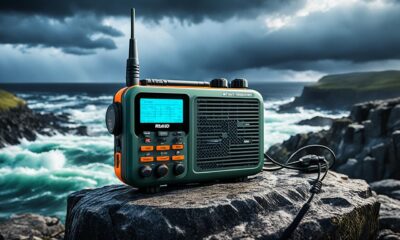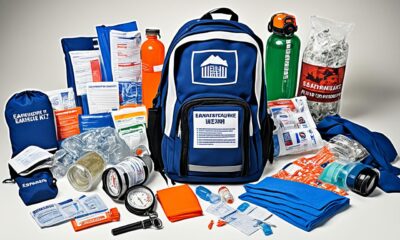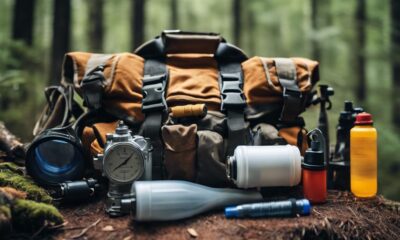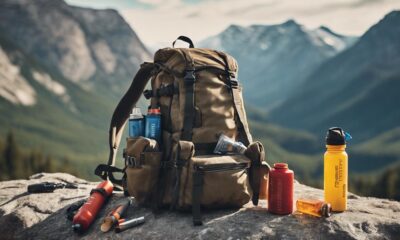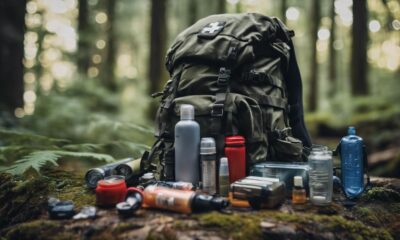Survivalism
Ultimate Tornado Survival Guide for Safety
Discover lifesaving tips with our Tornado Survival Guide, ensuring your safety during severe storms. Be prepared and protected when disaster strikes.

Tornadoes are dangerous and can quickly destroy areas. They have winds over 200 MPH1. The Midwest and Southeast of the U.S. face the most risk of tornadoes1. To keep safe, knowing what to do before, during, and after a tornado is key.
Key Takeaways:
- Stay updated on tornado watches and warnings issued by the National Weather Service2.
- Identify safe shelter locations, such as basements or storm shelters, in advance1.
- Avoid windows, doors, and outside walls during a tornado1.
- Use text messaging or social media to communicate with family and friends when phone systems are down1.
- After a tornado, be cautious during cleanup and wear protective gear to prevent injuries1.
Understanding Tornadoes and Their Rispectible Risks
Tornadoes are intense and can tear through towns, destroying almost everything. They come from severe thunderstorms and have wind speeds over 200 miles per hour3. Knowing about tornadoes and the dangers they bring is key to keep safe. It helps us to prepare and protect our lives and homes.
In the U.S., tornadoes mostly hit the Midwest and Southeast. These places see more tornadoes because of their weather3. People living there must be ready and know what to do when a tornado comes. Being informed means being safer.
FEMA has made rules for building safe rooms for tornado safety3. These rooms must be built strong to stand up against tornado winds. Following the ICC 500 shelter rules makes these safe spots even safer during a storm3.
When tornadoes could happen, alert systems warn us. The Emergency Alert System (EAS) and NOAA Weather Radio give these warnings3. They tell us what to do and how to find safety. This can save lives.
Meteorologists play a big role in keeping us safe from tornadoes. They use weather data to forecast tornadoes3. Their work helps us get ready and protects us and our families.
| Tornado Risk Factors | Impact |
|---|---|
| High Winds | Tornadoes can reach intense wind speeds, exceeding 200 miles per hour3. |
| Geographical Regions | The Midwest and Southeast regions in the U.S. have a higher risk for tornadoes3. |
| Safe Room Construction | FEMA criteria outline safe room construction for tornado protection3. |
| Storm Shelter Standards | Adhering to ICC 500 standards enhances protection during tornadoes3. |
| Emergency Alert Systems | Emergency Alert System (EAS) and NOAA Weather Radio deliver emergency alerts3. |
| Meteorological Predictions | Meteorologists can predict favorable conditions for tornado formation3. |
To stay safe from tornadoes, we need to understand them. Staying informed, following safety steps, and taking action helps protect us. This way, we can face these powerful storms with confidence.
Tornado Watches and Warnings
Knowing what to do during a tornado can save lives. Meteorological agencies give out watches and warnings to tell us about tornado risks. It’s important to know the difference between a tornado watch and a warning, so you can act safely.
Tornado Watch
A tornado watch means tornadoes could happen. It tells us the weather is right for tornadoes to form. When there’s a tornado watch, check your emergency plans and get your safe room ready. Make sure it’s free of mess and has things like blankets and pillows to protect you from flying stuff. Last year, tornadoes caused 83 deaths in the U.S4.. Over the last 10 years, about 47 people died each year due to tornadoes4.
Tornado Warning
A tornado warning is more serious. It means a tornado is actually happening or could any minute. This is the time to find shelter fast. If you’re outside, find shelter or lie flat on the ground, covering your head, away from things that could hit you. Safe buildings are best during a tornado.
If you’re in a car, drive away from the tornado or pull over, buckle up, and cover your head. In 2011, 553 people died because of tornadoes, making it the deadliest year since 19504.
People living in mobile homes should find a sturdy building. Mobile homes aren’t safe, even if they’re tied down4. Stay in your shelter until it’s safe to leave. Authorities will let you know when that is. Reacting quickly to tornado watches and warnings is key to staying safe.
Staying informed and ready is vital for survival during tornadoes. A NOAA Weather Radio can alert you quickly5. Also, listen to radio and TV for updates5. By paying attention to experts, you can lessen the danger from tornadoes and keep safe.
| Tornado Watches | Tornado Warnings |
|---|---|
| Issued to indicate the possibility of tornadoes in a specific area | Issued when a tornado has been sighted or rotation has been detected on weather radar |
| Signal the need to review emergency plans and prepare a safe room | Require immediate action to seek shelter |
| 83 tornado-related deaths reported in the U.S. last year | 2011 marked the deadliest year for tornadoes in the U.S. since 1950 |
| Average of 47 tornado-related deaths per year in the U.S. over the past decade | Mobile homes considered unsafe even with tie-downs |
Creating a Tornado Preparedness Plan
Having a plan ready for tornado safety is key to protect you and your family. This plan includes finding safe spots, doing drills, and getting together emergency supplies and ways to communicate.
Identifying Safe Locations
First, figure out the best places to hide during a tornado. Tornadoes have hit every state in the U.S., so it’s a threat everywhere6. They mostly happen in spring and summer but can appear at any time6. Tornadoes are very powerful, with winds over 200 miles per hour6.
Practicing Tornado Drills
It’s smart to practice tornado drills regularly. This helps everyone know what to do if a tornado is coming. It’s also important to keep up with weather warnings. You can do this by watching local news or listening to NOAA weather radio6. Paying attention to weather changes and unusual noises can also give you a heads up about tornadoes6.
Emergency Supplies and Communication Devices
Make sure you have an emergency kit ready. It should have things like medicine, durable shoes, and how to shut off house utilities during a tornado6. It’s also vital to stay in touch. Have a battery-powered radio, flashlights, and extra batteries ready. Weather updates and warnings are on NOAA Weather Radio and regular radio or TV stations6.
A well-thought-out tornado plan can greatly improve your safety. Don’t forget to practice drills, keep up with warnings, and gather emergency items and communication tools.
| Statistical Data | Source |
|---|---|
| Tornadoes have been reported in every state in the U.S. | Link 1 |
| Tornadoes typically occur during spring and summer, but can happen at any time throughout the year. | Link 1 |
| Tornadoes can have wind speeds of 200 miles per hour or more. | Link 1 |
| Conducting periodic tornado drills can help ensure preparedness. | Link 1 |
| It is crucial to stay informed about storm warnings. | Link 1 |
| Instructions should be in place for where to take shelter during a tornado. | Link 1 |
Identifying Safe Shelter Locations
When a tornado warning comes, you must find a strong shelter quickly. Look for safe rooms, basements, or ground-level interior rooms in solid buildings. Stay away from mobile homes and trailers; they are not safe in tornadoes.
Safe rooms or storm shelters are built to stand against tornadoes. They have strong walls and doors to keep you safe7.
Basements are great because they are underground. They protect against strong winds better. Always go to the deepest part, far from windows7.
If you don’t have a safe room or basement, use internal rooms. Pick places without windows near the center. Protect yourself with heavy furniture7.
Mobile homes and trailers are very dangerous in tornadoes. They can’t handle tornado winds. If you live in one, plan to find a safer place early8.
Know your area’s emergency shelter plans. Places like schools have safe spots. Learn where these are and how to get there in an emergency7.
If outside or in a car when a tornado warning is out, find a strong building. Never hide under overpasses. If nothing else is available, find a low spot and protect your head and neck78.
Always look for safe spots like safe rooms, basements, or inside sturdy buildings when tornado warnings are issued. Avoid mobile homes. Know where public safe spots are. If you’re caught outside, find safety in a solid building or lie low on the ground78.

Staying Informed and Monitoring Weather Conditions
It’s important to stay updated and watch the weather during a tornado. Getting timely tornado alerts helps keep you, your family, and your home safe.
“Tornadoes can occur at any time of day or night, with nighttime tornadoes being more challenging to see and detect, thus potentially increasing their danger.”9
To remain informed, sign up for tornado alerts from local authorities. These alerts will inform you about tornado dangers, so you can act fast to stay safe.
Have a battery-powered radio ready for emergencies. It will give you the latest news on tornadoes near you during severe storms.
Also, make sure you have a way to keep your phone charged. Your phone is crucial for getting tornado updates and using weather apps for the latest info.
“About 1,200 tornadoes hit the United States every year with every state being at risk.”10
Always keep an eye on weather reports. Knowing about tornado watches and warnings helps you decide when to seek shelter or leave the area.
Understand that a tornado watch means tornadoes could happen. A warning means one is already happening or will soon. Act quickly if you hear a tornado warning.
If you own a business, make sure you have a tornado safety plan. This should include safe places to go and ways to keep in touch with everyone.
“Businesses should have a tornado preparedness plan to protect employees and minimize operational disruptions during tornado events.”9
Staying alert and ready is key to being safe during a tornado. Make sure to get alerts, watch the weather, and have a safety plan ready.

Gathering Emergency Supplies
When dealing with tornadoes, having the right supplies is key to keep you and your family safe. Putting together a tornado emergency kit is a smart move. This kit can really help during a storm.
Start with enough water. You’ll need at least one gallon per person each day11 for drinking and staying clean. Try to have a three-day water supply as a basic amount.
Check your emergency kit twice a year12. This ensures all items are fresh and ready to use. You should do this every six months12.
Restock your kit regularly, too12. Update food, batteries, and medical items. This keeps your kit ready with what you need.
The location of your kit matters12. Store it somewhere easy to get to, like a basement or closet. This way, it’s quick to grab if you need to hurry out.
A good flashlight and extra batteries are must-haves12. They keep you lit during blackouts. Having spare batteries means your light stays on longer.
Don’t skimp on first aid supplies. Having bandages, ointment, and wipes12 is a must. These can handle minor injuries from tornadoes.
Remember a can opener12. It seems minor but is crucial for canned food. Make sure it’s manual to work without power.
Keep up your hygiene with toothbrushes, toothpaste, soap, and sanitizer12. Staying clean reduces illness risk during emergencies.
Choose kit items that fit your needs. Think about tools to turn off utilities, emergency books, and radios12. These help you stay safe and informed.
If you have babies, add formula and diapers12. Their comfort and care are important too.
Pets need extra food stored away12. They rely on you for their food during emergencies.
Air quality can drop. Dust masks or cotton shirts12 can filter air. They’re helpful when air is filled with particles.
Have plastic sheeting and duct tape ready12. Use them for quick shelter fixes against dangers. This is vital while waiting out a storm.
In wet areas, bring rain gear to keep dry12. It guards against rain and prevents mold from moisture.
Don’t forget basics like paper towels12. They help keep areas clean and sanitary. This is important during and after storms.
Carry a fire extinguisher12. It can control fires, protecting you from further harm.
To help with stress, pack cards or a game12. They offer a break from the tension of emergencies.

Wear the right clothes. Jackets, hats, gloves, and sturdy shoes12 are essential. They protect you from bad weather, especially in cold areas.
Understanding Tornado Warning Signs
Knowing tornado warning signs can lead to quick actions to keep you safe. You might see a twisting, funnel-shaped cloud or debris moving towards you. Or hear a loud noise similar to a freight train.
Spotting these signs is key to knowing a tornado is near. This knowledge lets you find shelter fast and stay safe.
Tornadoes can hit quickly, often without much warning. Being ready and alert is critical.
In Texas, tornadoes happen quite often13. For Texans, understanding tornado signs and safety steps is very important.
Weather experts send out tornado warnings when they spot one or see it on radar13. These warnings mean you should find a safe place right away. Listening and acting quickly can keep you safe.
Tornado emergencies are rare but very serious13. If there’s an emergency, act fast. Find a safe spot and follow safety rules.
Safety systems like sirens and special radios can warn people of tornadoes13. These tools help everyone respond quickly to stay safe.
Weather experts can predict when tornadoes might form13. They look at the weather and the atmosphere. This helps people and communities prepare and take action when needed.
If there’s a tornado warning, go to a room without windows on the lowest floor13. It’s the safest place from the tornado’s strong winds and flying debris.
Mobile homes don’t protect well in tornadoes. If you live in one, know where to go for safety13. Find a sturdy building or community shelter ahead of time.
Outside with no shelter? Lie flat in a low spot and cover your head13. It might offer some protection against debris.
After a tornado, signal for help without speaking if you’re stuck. Stay away from damaged buildings and downed power lines13. This keeps you safe from further harm.
Use texts or social media to communicate after a disaster13. Phone systems might not work. These can help you stay connected and organize help.
Wear thick shoes, pants, and gloves during clean-up for safety13. This gear protects you from debris and other dangers after a tornado.
It’s vital to know how to spot a tornado coming. Being aware and ready lets you act quickly when weather gets bad.
Taking Shelter and Staying Safe During a Tornado
When you hear a tornado warning, act fast and find shelter. Head to a safe room, basement, or an inside room on the ground floor without windows. Protect yourself with things like furniture or blankets. Keep away from windows and outer walls. The CDC strongly advises to seek shelter or find a tornado-safe room if a tornado is near14. The best spot to hide in your home is an interior part of a basement14. If you live in a high-rise or don’t have a basement, go to an inside room on the lowest floor. Stay far from windows1415. Mobile homes and cars are not safe places during a tornado15.
If you’re outside, the CDC says to lie low in a ditch or depression14. Reacting quickly is vital because tornadoes come fast14. At your shelter place, have an emergency supply kit ready16. This kit should have water, food that doesn’t spoil, first aid items, flashlights, and batteries.
If there’s a tornado warning, don’t use lifts. Use the stairs to get to safety. It’s also key to keep an eye on weather updates through trustworthy sources like weather radios, the news, or apps on your phone. Following OSHA’s advice to have warning systems and safety procedures during tornadoes is smart16.
Once the tornado warning is over and it’s safe, be cautious leaving your shelter. Look out for dangers like fallen power lines, debris, and broken buildings. Listen to local authorities and emergency teams for advice on going back to damaged areas.
After a tornado, contacting others might be hard. Phone lines could be busy or not working. To stay in touch, texting or using social media is suggested. The Tuscaloosa County EMA lists storm shelters in Tuscaloosa County for those not living on campus15.
| Tornado Safety Precaution | Statistical Data Reference |
|---|---|
| Seek shelter in a safe room, basement, or interior room on the lowest level of a sturdy building without windows | 14 |
| Cover yourself with protective materials, such as furniture or blankets | – |
| Avoid windows and outside walls | – |
| Equip shelter locations with emergency supply kits | 16 |
| Monitor weather conditions through reliable sources | 16 |
| Avoid using elevators and take the stairs | – |
| Exercise caution when leaving the shelter location | – |
| Use text moreessages or social media for post-tornado communication | 15 |
Safety Precautions After a Tornado
After a tornado hit, it’s key to act fast to keep safe. You need to check the damage, help others, and watch out for dangers. Doing these can help everyone recover quicker.
Assessing Damage
When it’s safe, look over your property for damage. Search for big problems like broken walls or roofs, and avoid fallen power lines. Remember, it’s important to take pictures for insurance.
Helping Others
Now is the time to help those around you. Check on neighbors, friends, and family. If anyone is hurt, call 911 right away and help out if you know CPR. Your help can really make a difference.
Safeguarding Against Hazards
Be careful of hazards in places hit by the tornado. Stay away from damaged buildings which might fall down. Make sure to wear gloves, boots, and a mask to stay safe from debris and germs.
It’s also vital to keep up with news for more weather alerts. Using texts and social media works best for updates because phone lines might be busy.

By taking these steps and helping others, you play a big part in the recovery. Staying safe after a tornado is important for getting things back to normal quickly.
| Tornado Safety Guidelines and Tips | Tornado Watch17 | Tornado Warning2 |
|---|---|---|
| Stay informed through NOAA weather radio or local broadcast media. | Covers a large area including numerous counties or even states. | Issued when a developing tornado is detected, usually covering portions of one or two counties for an hour or less. |
| Seek shelter in a basement or the lowest floor of a building. | It is recommended to have a family emergency plan, including a safe room in the home, such as a basement or storm cellar17. | Recommends seeking basement or lowest floor of a building, putting as many walls between oneself and the outside, avoiding windows, and preparing for obscured tornadoes especially at night2. |
| Avoid windows and put as many walls between yourself and the outside as possible. | ||
| Have a family emergency plan in place. | ||
| If no shelter is available in a tornado-prone area, consider relocating to a sturdier building or structure. | Guidance against taking shelter under highway overpasses2. | |
| Listen to local news for updates on possible additional tornado watches or warnings. | Continue listening to local news for updates on possible additional tornado watches or warnings17. | |
| Communicate through text messages or social media rather than phone calls, as they are more reliable forms of communication after a tornado. | Text messages or social media are suggested as more reliable forms of communication after a tornado than phone calls17. | |
| Check for property damage and be cautious of hazards like downed power lines. | It is important to check for property damage after a tornado and be cautious of dangers like downed power lines17. | |
| Call 911 and provide first aid if trained to do so if someone is injured. | If someone is injured, it is advised to call 911 and provide first aid if trained until emergency responders arrive17. |
Mental and Emotional Well-being
Experiencing a tornado can leave you feeling shocked and unsure. It’s not just about the destruction you see18. It also leaves deep emotional scars, affecting both victims and those who hear about it18. People often react strongly to such trauma18.
After a tornado, it’s vital to look after your mental health. If emotional issues linger, getting help from a therapist might be needed18. Talking to loved ones, writing about your feelings, or joining a support group can help heal your heart18.
Staying healthy is key to dealing with stress. Eat well, rest enough, and skip alcohol and drugs18. Keeping to a regular schedule can make you feel safer and more secure during tough times18.
Helping others also helps you. It can make you feel in control and boost your mood18. Supporting those in need can positively affect your feelings18.
Avoid big decisions, like switching jobs, while recovering from a tornado. This reduces stress, helping you focus on emotional healing18.
For kids acting out, pulling away, or struggling in school, expert help might be needed. Mental health pros help kids and adults manage stress in healthy ways18.
Seek help if distress doesn’t improve. This includes persistent worry, fear, or anger lasting over two weeks19. The SAMHSA’s Disaster Distress Helpline offers crisis counseling round-the-clock19. The 988 Suicide & Crisis Lifeline is there for those feeling alone or considering suicide19.
In summary, healing from a tornado means taking care of your mental health. Talk about your experiences, maintain health, establish routines18. Offer assistance, avoid quick decisions, and seek professional advice when needed18. These actions lay the foundation for recovery and emotional resilience, helping you overcome tornado-related challenges18.
Additional Resources and Assistance
When it comes to staying safe from tornadoes, knowing where to find help is key. Many groups and networks are ready to offer advice, information, and aid. Here’s a list of helpful places for tornado safety tips and disaster relief help:
American Red Cross
The American Red Cross helps people during disasters like tornadoes. They give out emergency shelter, food, and supplies. For tips on getting ready for tornadoes, and help after one hits, visit their site or reach out to your local chapter20.
Federal Emergency Management Agency (FEMA)
FEMA works under the U.S. Department of Homeland Security. They handle disaster response and help communities and people in emergency situations, including tornadoes. They offer guides and programs for preparing and recovering from tornadoes. Check their website for detailed help and support20.
Local Government Agencies
Your local emergency management offices are great for information on tornado safety and help. They offer advice on emergency plans and alerts specifically for your area. Contact them to stay updated and access local support20.
Community Support Networks
During disasters, communities band together to help each other. Local groups, churches, and centers provide emergency items, places to stay, and emotional care. Look for community groups nearby to find help and support during tornadoes20.
Make use of these resources and ask for help to find important information and support during tornado situations. Being prepared and informed is vital for your safety and recovery.
Conclusion
Tornadoes are wild and harmful disasters that hit hard in Canada and the U.S. Storms, like thunder, hail, and tornadoes, come quickly. They put people and their homes in danger all year. It’s key to know the dangers in your area and make a plan that fits those risks21.
Having a plan for tornadoes, knowing safe places, and following weather alerts can really help. A safe place can lower the chance of getting hurt by 80%. This shows how crucial it is to find shelter during tornadoes22. Also, having an emergency kit is super important. It has supplies you’ll need right after a tornado, which helps people survive22.
Tornadoes can happen any time, but they’re most common in spring – March, April, and May23. It’s important to watch the weather because tornado watches give about 6 hours to get ready22. When a tornado warning comes, you have about 13 minutes to act fast. This means finding shelter quickly22.
To make it through a tornado, be well-prepared, stay updated, and act fast when needed. Safety is first. Practice drills and get help recovering after a storm. Stay safe, get ready, and keep up with the latest weather news during tornado seasons212322.FAQ
What is a tornado?
What is the difference between a tornado watch and a tornado warning?
How can I create a tornado preparedness plan?
Where should I seek shelter during a tornado?
How can I stay informed about tornado watches and warnings?
What should I include in my tornado emergency kit?
What are the warning signs of an approaching tornado?
What safety precautions should I take during a tornado?
What should I do after a tornado passes?
How can I take care of my mental and emotional well-being after experiencing a tornado?
Where can I find additional resources and assistance regarding tornado safety and recovery?
Are the Survival Tips for Tornadoes and Earthquakes Similar?
When it comes to preparing for natural disasters, such as tornadoes and earthquakes, having earthquake survival kits & tips can be crucial. While the immediate dangers and aftermath of these events may differ, the basic principles of preparedness, including having emergency supplies and a plan, are similar for both situations.
Source Links
- BE PREPARED FOR A TORNADO
- Tornado Safety Rules
- Tornadoes | Ready.gov
- What to do during a tornado warning: How to stay safe at home, outside, in a car
- Tornado Preparedness Tips for School Administrators
- Tornado Preparedness Guide And Resources
- Tornado Safety Tips
- Taking Shelter
- How to Survive in Tornado Season
- How to Prepare for a Tornado
- Build A Kit | Ready.gov
- Emergency Supplies Kit
- Tornado Preparedness
- Safety Guidelines: During a Tornado
- Tornadoes: Tips to Stay Safe Before, During and After
- Tornado Preparedness and Response – Preparedness
- Managing traumatic stress: After a tornado
- Coping Tips for Traumatic Events and Disasters
- How to Help Prepare for Tornadoes | Travelers Insurance
- Severe Storms – What to Do?
- How to Stay Safe During a Tornado?
- Local Government Tornado Mitigation & Disaster Plan 2023 | GovPilot
Survivalism
Taste-Tested MRE Kits: Meals for Adventure
Perfect for outdoor enthusiasts, taste-tested MRE kits deliver delicious meals on-the-go, but what flavors will fuel your next adventure? Discover more inside!

Taste-tested MRE kits are your go-to for tasty, nutritious meals on your outdoor adventures. Designed for portability and convenience, these Meals Ready-to-Eat provide you with balanced nutrition, offering 800 to 1,200 calories per meal. Whether you crave hearty beef stew or zesty chicken and rice, there's an MRE flavor for every palate. You won't need to cook; just pack them in your backpack and hit the trail. Store them in a cool, dry place for maximum shelf life, ensuring you always have delicious options on hand. Keep exploring to find even more about selecting the best MREs for your adventures!
Key Takeaways
- MREs provide convenient, nutritious meals with 800 to 1,200 calories, perfect for fueling outdoor adventures.
- Popular flavors include hearty beef stew, zesty chicken and rice, and creamy macaroni and cheese, catering to diverse tastes.
- MREs require no cooking, making them easy to pack and consume during outdoor activities.
- Proper storage in cool, dry places extends shelf life to 12-24 months, ensuring readiness for excursions.
- Regular taste testing helps identify preferred flavors and meal options for an enjoyable outdoor dining experience.
Overview of MRE Kits

MRE kits, or Meals Ready-to-Eat, are an essential solution for anyone venturing into the great outdoors or preparing for emergencies.
Developed in the 1980s for military use, these convenient meals have evolved greatly, offering a wide range of flavors and increased nutritional value for both military personnel and civilians.
You can find various MRE kits that cater to different tastes and calorie requirements, making them practical for camping trips, hiking, or unexpected situations.
To guarantee their longevity, it's important to store MREs in a cool, dry place, as they typically last between 12 to 24 months.
With their ease of use and portability, MREs are a reliable choice for fueling your adventures or emergency preparedness plans.
Nutritional Benefits of MREs
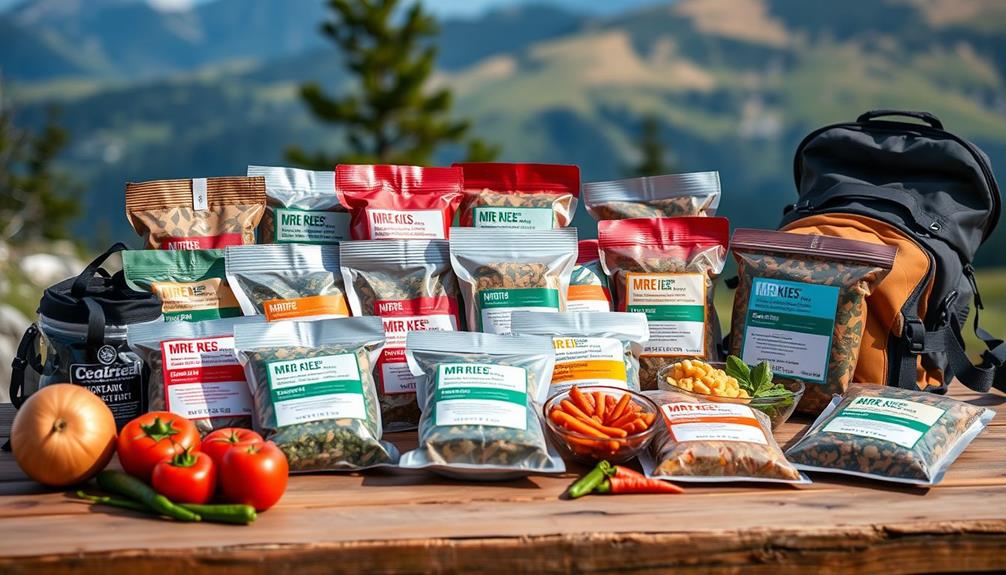
When you're out in the wilderness or preparing for an emergency, having meals that provide balanced nutrition is essential. MREs are designed to deliver just that, typically containing a mix of proteins, carbohydrates, and fats, along with essential vitamins and minerals.
Each meal generally offers between 800 to 1,200 calories, ensuring you have enough energy for your adventures. Depending on the brand and flavor, the nutritional profiles may vary, but you can find options that cater to specific dietary needs.
Whether you're hiking, camping, or facing an emergency, MREs help you maintain your strength and stamina. So, you can focus on your experience without worrying about fueling your body effectively.
Flavor Testing Techniques

Taste testing is an essential step in evaluating MREs, ensuring they not only provide the necessary nutrition but also satisfy your palate.
To start, gather a variety of MREs that showcase different flavors and textures. Set up a comfortable tasting environment where you can focus on each meal without distractions.
As you taste each item, pay attention to the aroma, flavor balance, and mouthfeel. Use a scoring system to rate each meal based on taste, texture, and overall satisfaction.
Don't forget to involve others in the tasting process for diverse opinions. Document your findings to make informed choices for future adventures, ensuring you select MREs that truly delight your taste buds while keeping you energized on the go.
Popular MRE Flavors

Among the diverse offerings of MRE kits, certain flavors stand out as favorites among outdoor enthusiasts and emergency prepper communities.
These flavors not only satisfy your hunger but also evoke comfort and nostalgia during your adventures. When you're out in the wild or preparing for the unexpected, these popular choices will keep your spirits high:
- Hearty beef stew, warming your soul
- Zesty chicken and rice, bursting with flavor
- Creamy macaroni and cheese, a classic indulgence
- Flavorful chili with beans, hearty and filling
- Sweet apple cobbler, a delightful treat
Each bite brings a sense of satisfaction, making your meals not just fuel but a source of joy, no matter where you are.
Selecting the Right MRE

Choosing the right MRE kit is essential for ensuring a satisfying and nutritious meal during your outdoor adventures or in emergencies.
Start by pondering your taste preferences; if you enjoy hearty meals, look for options like beef stew or chili.
Next, check the nutritional content—aim for meals that provide a balanced mix of proteins, carbs, and fats.
Think about calorie counts too; you'll want meals that keep your energy up, especially during strenuous activities.
Don't forget to take meal variety into account; having different flavors can keep your meals exciting.
Finally, choose MREs that include dietary options like vegetarian or gluten-free meals, ensuring everyone in your group has something to enjoy.
Your choice can make all the difference in your experience!
Storage and Shelf Life

Once you've selected the right MRE kit for your adventure, proper storage becomes essential to confirm your meals stay fresh and safe to consume.
Keep your MREs in a cool, dry place, ideally between 50°F and 70°F. Avoid exposure to moisture and extreme temperatures, as these factors can shorten their shelf life.
Regularly check expiration dates to confirm your meals remain safe to eat.
- Imagine the joy of a warm meal after a long day outdoors.
- Picture the comfort of knowing you've packed nutrition for your journey.
- Feel the peace of mind during emergencies with your food supply secure.
- Envision delicious flavors waiting for you after an exhausting hike.
- Anticipate the satisfaction of a meal that's still fresh and safe!
MREs for Outdoor Adventures

MREs are a fantastic option for outdoor adventures, providing you with convenient, nutritious meals that require no cooking.
Whether you're hiking, camping, or exploring, these ready-to-eat meals fit perfectly in your backpack, saving space and weight. They come in a variety of flavors, ensuring you won't get bored with your meals on the trail.
Plus, with caloric content ranging from 800 to 1,200 calories, they give you the energy you need to tackle those challenging hikes.
MREs have a long shelf life, so you can stock up and be prepared for any outdoor excursion. Just remember to check the expiration dates, and you'll enjoy tasty, satisfying meals wherever your adventures take you!
Frequently Asked Questions
Are MRES Suitable for People With Food Allergies?
Yes, MREs can be suitable for people with food allergies, but you should carefully check ingredient labels. Many brands offer allergen-free options, so always choose meals that meet your specific dietary needs and restrictions.
Can MRES Be Consumed Without Heating?
Did you know that MREs can provide up to 1,200 calories per meal? Yes, you can eat them straight from the package without heating, making them convenient for emergencies or on-the-go situations. Enjoy!
What Are the Best Drinks to Pair With Mres?
When pairing drinks with MREs, you can't go wrong with water, sports drinks, or flavored electrolyte beverages. They hydrate and enhance flavors, making your meal more enjoyable. Avoid overly sweet drinks that might overwhelm the taste.
How Do MRES Compare to Traditional Camping Meals?
When you think of camping meals, MREs offer convenience, variety, and longevity, unlike traditional options that require cooking. With balanced nutrition and easy storage, they're perfect for quick, hassle-free outdoor dining whenever hunger strikes.
Are There MRE Kits Specifically Designed for Kids?
Yes, there are MRE kits designed specifically for kids. These kits often feature kid-friendly flavors and smaller portions, making them appealing and easy for children to enjoy during camping trips or emergencies.
Conclusion
In the grand adventure of life, don't let mealtime be an afterthought. With taste-tested MRE kits, you can savor each bite like a feast fit for explorers of old. Whether you're hiking through rugged terrain or preparing for the unexpected, these meals bring both nourishment and delight to your journey. So gear up, pack your favorites, and set forth—your next culinary adventure awaits, ready to fuel your spirit and satisfy your appetite.
Survivalism
Redundancy: Your Key to Survival Success
The importance of redundancy in survival is undeniable, but what are the crucial strategies you need to know for ultimate preparedness?

Redundancy is essential for your survival success. It boosts safety and reliability when crises strike. By having backup systems, like a secondary water filtration setup, you increase your chances of hydration and survival. Familiarizing yourself with this redundant gear enhances your efficiency in emergencies. It's not just about having it; it's about knowing how to use it. This thorough preparedness helps you handle unforeseen challenges more effectively. Prioritize your bug-out bag with versatile tools and essential supplies. Stay proactive in your training, and you'll build the confidence needed for any situation. Discover more strategies to enhance your survival readiness.
Key Takeaways
- Redundancy in gear, such as backup water filtration systems, enhances safety and reliability during emergencies.
- Familiarity with redundant tools boosts efficiency and confidence when facing unexpected situations.
- Comprehensive planning with redundant essentials increases overall preparedness and survival chances.
- Multi-functional gear and versatile tools contribute to redundancy, maximizing space and effectiveness.
- Regularly practicing with backup gear ensures adaptability and readiness in crisis scenarios.
Importance of Redundancy in Gear

When it comes to survival gear, redundancy is essential for ensuring your safety and success during emergencies. Having backup items can greatly enhance your reliability, especially when unexpected challenges arise.
For instance, if your primary water filtration system fails, a secondary one can keep you hydrated. This safety net allows you to stay focused, knowing you're prepared for various scenarios.
Familiarizing yourself with these redundant items boosts your efficiency during crises, as you won't waste precious time figuring out how to use them. Embracing redundancy in your planning not only enhances your readiness but also increases your chances of survival.
Ultimately, the more prepared you are, the better equipped you'll be to handle whatever comes your way.
Essentials for Your Bug-Out Bag

A well-prepared bug-out bag can be your lifeline in an emergency. Start by including a reliable shelter like a lightweight tarp or tent; survival without shelter can last only three hours.
Additionally, consider incorporating multi-functional gear to maximize space and efficiency. Next, pack a water filtration system, as you can only survive about three days without water.
Don't forget lightweight, calorie-dense food options, guaranteeing you have enough sustenance for at least three weeks. A well-stocked first-aid kit is essential for treating injuries.
Include a multi-tool for versatile tasks and a reliable flashlight for visibility. Regularly check and update your bag to guarantee everything remains functional and relevant.
This preparation can greatly increase your chances of survival when every second counts.
Versatility in Survival Tools

Versatile survival tools can make a significant difference in emergency situations. They maximize your gear's effectiveness, ensuring you're prepared for various challenges.
A multi-tool, for instance, combines several functions—like cutting, screwing, and opening bottles—into one compact device, saving space in your pack.
Paracord is another essential; it can secure items, create shelters, or even serve as a tourniquet in a pinch.
Don't underestimate simple items like a bandana, which can filter water or signal for help.
Duct tape also excels with countless applications, from quick repairs to marking trails.
Packing Strategies for Efficiency

Effective packing strategies are essential for maximizing efficiency in emergency situations.
To guarantee you're prepared, consider these key tactics:
- Prioritize Essentials: Always pack air, water, and shelter first.
- Use Durable Containers: Store non-perishable food in pest-resistant, durable containers.
- Organize Gear: Utilize ziplock bags or packing cubes for easy access and visibility.
- Distribute Weight Evenly: Balance your pack to enhance comfort and mobility during travel.
Mindset for Preparedness and Growth

Cultivating a proactive mindset is essential for fostering preparedness and growth in survival situations. You need to recognize that each challenge offers an opportunity to learn and improve, as emphasized in quotes on authenticity and existence that encourage deeper self-reflection.
By embracing a culture of continuous improvement, you can enhance your skills and adaptability. Regularly practice using your gear in real-world scenarios, so you'll become familiar with your equipment and its redundancies.
Short-term sacrifices, like investing time in training, lead to long-term stability and confidence when emergencies arise. Evaluate your strategies regularly, adjusting based on what works best for you.
Frequently Asked Questions
How Can I Assess the Quality of My Survival Gear?
To assess your survival gear's quality, regularly test each item's functionality, check for durability, and guarantee everything's up-to-date. Evaluate how well they meet your needs in various scenarios to boost your preparedness.
What Should I Do if I Lose My Bug-Out Bag?
If you lose your bug-out bag, stay calm and assess your surroundings. Prioritize finding shelter, water, and food. Use alternative resources or local supplies, and remember to adapt your plans for future preparedness.
Are There Specific Brands Known for Reliable Survival Gear?
When you're traversing the wilderness, think of survival gear as your lifeline. Brands like Gerber, LifeStraw, and Coleman deliver reliability. Trust their products, and you'll feel more secure in any emergency situation.
How Often Should I Practice Using My Survival Equipment?
You should practice using your survival equipment regularly, ideally every few months. This keeps your skills sharp, guarantees everything's functional, and prepares you for real-life situations, boosting your confidence and effectiveness when it counts.
What Are Common Mistakes People Make When Preparing Survival Gear?
When preparing survival gear, you often overlook the importance of redundancy, forget to test your equipment, pack too much, or choose low-quality items. Stay organized, prioritize essentials, and regularly evaluate your gear for effectiveness.
Conclusion
So, there you have it—embracing redundancy in your survival kit isn't just smart; it's downright essential. After all, who wouldn't want to lug around a backpack full of backup gear just in case the universe decides to throw a tantrum? Think of it as your very own insurance policy against chaos. With a little extra weight on your back, you'll not only survive; you'll do it with style, looking like a well-equipped squirrel ready for hibernation!
Survivalism
Essential Long-Term Food Storage Tips for Preppers
Always be prepared with essential long-term food storage tips that ensure your supplies remain fresh and secure—discover the secrets that every prepper needs to know.

To guarantee your long-term food storage is effective, start by using airtight containers like Mylar bags with oxygen absorbers to keep moisture and pests at bay. Stock up on grains like white rice, which lasts indefinitely, and dried beans that can last for years. Canned foods are excellent too, requiring no refrigeration and offering a shelf life of up to five years. Freeze-dried options can last up to 25 years, retaining nutrients and flavor. Regularly check your inventory and rotate supplies to maintain freshness. Keep learning about essential techniques and practices to enhance your preparedness strategy.
Key Takeaways
- Use airtight containers or Mylar bags with oxygen absorbers to protect grains and beans from moisture and pests.
- Store food in a cool, dark, and dry place to maximize shelf life and prevent spoilage.
- Regularly check and rotate supplies to ensure freshness and maintain an accurate inventory of your food storage.
- Incorporate a variety of foods like grains, dried beans, canned goods, and freeze-dried options for a balanced diet.
- Learn proper canning methods to safely preserve high-acid and low-acid foods for long-term storage.
Importance of Long-Term Food Storage

When it comes to prepping, you can't overlook the importance of long-term food storage. Having a well-stocked pantry guarantees you're prepared for emergencies or unexpected events.
By diversifying your food storage options, like grains, dried beans, and canned goods, you maintain a balanced diet and keep your meals interesting. It's vital to regularly monitor your inventory, helping you track freshness and prevent spoilage.
Long-term food storage not only provides security but also peace of mind, knowing you're ready for anything life throws your way. Prioritizing these preparations can make a significant difference in your overall resilience.
Techniques for Storing Grains

Properly storing grains is essential for maintaining their longevity and nutritional value.
Begin by selecting airtight containers or Mylar bags with oxygen absorbers to keep moisture and pests at bay. For items like white rice, you can achieve an indefinite shelf life, while brown rice lasts about 12 months due to its higher oil content.
Consider using nitrogen-packed cans for dark hard wheat to enhance preservation. Always store your grains in a cool, dry, and dark environment to prevent spoilage.
If you plan to grind your grains, a hand-cranked grain mill lets you enjoy fresh flour when needed.
Regularly check your supplies, and rotate them to guarantee freshness as you consume your stored grains.
Storing Dried Beans Effectively

Dried beans are a fantastic choice for long-term food storage, offering both nutritional value and versatility in meals.
To store them effectively, follow these key tips:
- Use Airtight Containers: Store beans in airtight containers or vacuum-sealed bags to prevent moisture and pests from ruining your supply.
- Keep in a Cool, Dark Place: Choose a storage location that's cool, dark, and dry to maximize shelf life and maintain quality.
- Rotate Your Stock: Regularly check your inventory and rotate your beans to guarantee you use the oldest first, maintaining freshness.
Benefits of Canned Foods

Canned foods offer numerous benefits that make them a staple in long-term food storage. They're convenient, require no refrigeration, and have an extended shelf life of up to five years. You can easily incorporate them into your meals with minimal preparation, making them perfect during emergencies.
| Type | Shelf Life | Nutritional Value |
|---|---|---|
| Canned Meat | Up to 5 yrs | High in protein |
| Canned Veggies | Up to 5 yrs | Rich in vitamins |
| Canned Fruits | Up to 5 yrs | Good source of fiber |
| Soups | Up to 5 yrs | Comforting, filling |
| Chili | Up to 5 yrs | Packed with protein |
These foods retain significant nutrients, ensuring you maintain a balanced diet even in challenging times. Embrace canned goods for your long-term storage strategy.
Advantages of Freeze-Dried Options

While canned goods are a convenient choice for long-term food storage, freeze-dried options offer distinct advantages that make them a smart addition to your pantry.
These foods can last up to 25 years, ensuring you have nutritious meals ready when you need them most. Plus, they retain 90-95% of their original flavor and nutrients, giving you tasty and healthy options.
Here are three key benefits of freeze-dried foods:
- Lightweight and Compact: Easy to store and transport, perfect for emergency kits.
- Quick Preparation: Just add water, making meal prep simple and fast.
- Diverse Options: From fruits to full meals, variety helps maintain a balanced diet.
Incorporating freeze-dried foods enhances your long-term food storage strategy.
Proper Canning Methods

When it comes to preserving your harvest or bulk purchases, mastering proper canning methods is essential for long-term food storage. You need to know the difference between high-acid and low-acid foods. High-acid foods, like tomatoes and pickles, require the water bath method, while low-acid foods, such as meats and vegetables, need pressure canning for safety.
| Food Type | Canning Method |
|---|---|
| High-Acid | Water Bath |
| Low-Acid | Pressure Canning |
| Safety First | Always Check Seals |
Best Storage Practices and Containers

Maximizing the longevity of your food storage hinges on using the right containers and practices.
Choosing effective storage options can greatly enhance your food's lifespan and quality. Here are three essential tips to take into account:
- Airtight Containers: Use Mylar bags or vacuum-sealed bags to keep air and moisture out, ensuring freshness.
- Cool, Dark Locations: Store your food in a cool, dark, and dry area. This helps prevent spoilage and nutrient loss.
- Regular Monitoring: Check temperature and humidity levels periodically, and incorporate desiccants to minimize moisture impact.
Frequently Asked Questions
How Do I Determine My Long-Term Food Storage Needs?
To determine your long-term food storage needs, assess your household size, dietary preferences, and emergency duration. Calculate the daily food intake required, then multiply by the number of days you want to prepare for.
What Are the Best Foods for Long-Term Storage?
For long-term storage, focus on grains, dried beans, canned meats, and freeze-dried foods. They're nutrient-dense and have extended shelf lives, ensuring you have a reliable food supply during emergencies or unexpected situations.
How Often Should I Rotate My Food Supplies?
You should rotate your food supplies every six months to guarantee freshness. Regularly check expiration dates and consume older items first, maintaining an organized inventory for easy access and efficient usage of your stored food.
Can I Store Food in My Garage or Shed?
You can store food in your garage or shed, but make sure it's temperature-controlled. Extreme heat or cold can spoil items. Use airtight containers to protect against pests and moisture for ideal preservation.
What Are the Signs of Food Spoilage in Storage?
You'll notice food spoilage by changes in color, texture, or smell. Mold growth, bulging cans, and unusual odors are clear signs. Always check expiration dates, and when in doubt, throw it out to guarantee safety.
Conclusion
In a world where surprise emergencies can strike like a lightning bolt, mastering long-term food storage isn't just smart—it's downright heroic! Picture yourself as the ultimate prepper, with a pantry bursting at the seams with life-sustaining treasures. You won't just survive; you'll thrive while others scramble! So, immerse yourself in these tips and techniques, and transform your food storage game into an impenetrable fortress. Your future self will thank you as you reign supreme in the face of uncertainty!
-

 Survivalism3 months ago
Survivalism3 months agoPreppers Pack Crossword: Test Your Knowledge of Survival Gear!
-

 Survivalism3 months ago
Survivalism3 months agoMeal Preppers Near Me: Find Local Services and Tips!
-

 Survivalism3 months ago
Survivalism3 months agoInside the Secret World of Doomsday Preppers: Are You Ready?
-

 Survivalism3 months ago
Survivalism3 months agoAI Doomsday Scenario: Understanding the Potential Risks
-

 Vetted3 months ago
Vetted3 months ago15 Best Satellite Phones for Preppers: Stay Connected Anywhere, Anytime
-
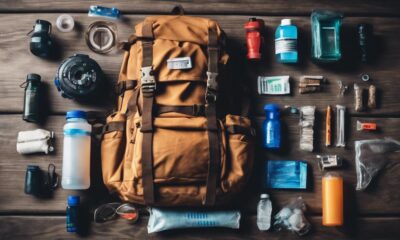
 Survivalism2 months ago
Survivalism2 months agoPreppers List of Items: Essential Gear for Every Survivalist!
-

 Survivalism3 months ago
Survivalism3 months agoMastering Hurricane Preparedness: Your Essential Guide
-
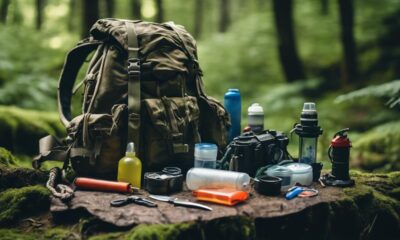
 Vetted2 months ago
Vetted2 months ago15 Essential Survival Gear Items You Need to Stay Prepared in the Wild





